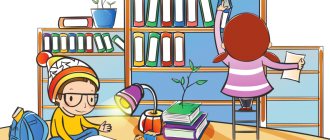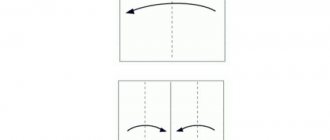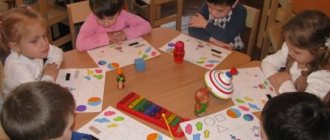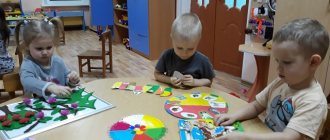Card index of construction games for children of the younger group
Natalia Vasilievna Volokitkina
Card index of construction games for children of the younger group
" Building a house for a cat , a dog and a goat"
Goal: Develop children's to build a house . Learn to build in the required sequence. Promote cooperative play
Material: cubes and bricks, plates.
Progress of the game: - Look, it’s raining, and our puppy Bimka is wet, he’s sitting under a tree and shaking. He needs to build a warm house - a booth. The teacher suggests building a house for the dog . Children select the materials themselves and invent the house themselves.
"Animal pen"
Goal: Learn to build from vertically placed bricks. Foster careful handling of construction . Activate vocabulary: brick, pen
Material: bricks.
Progress of the game: The teacher brings a set of plastic pets and offers to build a pen for them so that they do not run away and are not eaten by wolves. It must be built from bricks placed vertically.
" Building a truck , roads"
Goal: To consolidate the ability to tightly lay bricks flat to each other with the narrow short side (road)
.
Place the cube firmly and evenly on the second brick (machine)
.
Material: cubes and bricks.
Progress of the game: The teacher brings a traffic light to the group , the children remember what they know about the traffic light. Let's build a road and a car , shows how to build , plays with buildings .
"Gate for Aibolit car"
Goal: Learn to build a gate from two vertically standing bricks, on which another brick is placed. Material: bricks
Progress of the game: Attention, the tiger in the zoo is sick. The good doctor Aibolit is driving a car to cure a sick person. The car enters the park, trees prevent us from driving further. You and I urgently need to build a gate for the car . Children offer their buildings .
"The doll has a housewarming party"
Goal: To consolidate the skills and abilities of working with building materials , teach how to play with buildings , and enrich the experience of children . Construction of furniture , rooms in various ways.
Material: cubes and bricks. prisms, plates. cylinders.
Progress of the game: The teacher invites the children to become builders and build entire rooms with furniture for the dolls. Choose your own building material . Friends for work, and placing the dolls in a new home.
"Town for Dolls"
Goal: Continue to create buildings according to the general plot .
Material: prism cubes and bricks, plates. cylinders.
Progress of the game: - Look, our dolls were very upset , they had a fire, all the houses in the city burned down. Therefore, they need to be helped and built new houses . Let us help our toys, create our own houses, come up with our own buildings .
"Folding the figures"
Goal: Acquaintance with the concepts of shape, color, size, creation of initial mathematical concepts: acquaintance with geometric figures, their main features, learning to count.
Material: a set of planar geometric shapes in primary colors, frames, cut shapes.
How to play: Take out the inserts, for example circles, and invite the child to collect them on the table, and then put them in the corresponding windows. Then assemble triangles and squares in the same way.
“We come up with figures”
Goal: To develop logical thinking, attention, memory, speech, development of fine motor skills, preparing the hand for writing, development of imagination, creative activity.
Material: a set of planar geometric shapes in primary colors, frames, cut shapes.
Progress of the game: The child can come up with and put together figures from various elements, give them names.
“A narrow bench for Bunny - Long Ear, a wide bench for Mishutka”
Goal: Learn to build a narrow bench from two bricks and a plate and a wide bench from four bricks and two plates.
Material: bricks and plates.
Progress of the game: Funny toys come to visit the children and tell the children that there are not even benches in the forest. The teacher invites the children to build a narrow bench for the bunny, and a wide bench for the bear. Children themselves select materials for construction .
"Collect circles"
Goal: To strengthen children’s to navigate homogeneous objects (larger, smaller, even smaller, small, selecting them in a certain sequence; teach them to enrich sensory experience when acting with a certain shape and different sizes, learning their physical properties.
Material: flat circles of different sizes and colors.
Progress of the game: Let's create a fairy-tale room and arrange the circles according to size, color, and your mood .
"Bridge for pedestrians"
Goal: Continue to learn two ladders and make an overlap (put a plate on top, play with the construction . Vocabulary: ladder, height, on top, bridge, next to, plate.
Material: cubes and bricks, plate
Progress of the game: Here we have a wide river. And you and I need to translate the toys. - What should we do? Of course, build a bridge . (The teacher builds a sample )
Invites children to build their own bridge and transport toys.
"Different Cars"
Goal: To strengthen children's understanding of the color and name of building parts .
Material: cubes and bricks, plates.
Progress of the game: You and I have already built a road and a car . and now you can come up with your own cars and build a whole garage of various cars. Children compare buildings . Name their cars.
Joint design activities in the 2nd junior group.
Summary of joint design activities in the 2nd junior group on the topic: “Gates for trucks.” Integration of educational areas: physical, cognitive, artistic-aesthetic, social-communicative, speech development.
Goal: To develop in children the ability to build gates: place supports (exactly one against the other) and carefully place a crossbar (brick) on them, decorate them (prism). To develop in children the ability to analyze a sample building.
Tasks:
- Cultivate a desire to build buildings.
- Arouse children's interest in activities with wooden building materials.
- Develop the ability to listen carefully to the teacher and answer questions posed.
- Improve constructive skills.
Preliminary work:
- Guessing riddles.
- Development of skills to understand schematic images of buildings.
- Learning finger gymnastics, physical. Minutes, round dance “Christmas tree - Christmas tree”
Materials: 1 large car with a multi-colored ball, for children small cars with 1 ball each in its own color, gate diagrams for each child (large and small), 2 cubes, one long brick, one prism (for children), 4 cubes, brick, prism (to the teacher), an envelope with a letter from a snowman, a Christmas tree.
Contents of organizational activities: Children enter the group room, stand near the tree with a covered sheet.
The teacher makes a riddle about the Christmas tree:
- What kind of girl is this? Not a seamstress, not a craftswoman. She doesn’t sew anything herself, but wears needles all year round ?
We also have a Christmas tree, but is something missing? (toys) What to do? (there is a letter by the tree) Look here there is a letter from the Snowman, now I will read it. Hello guys! Trucks with toys are stuck behind the fence and need help to bring toys for the Christmas tree. Here's a diagram for you. Children go to the tables and look at the diagrams.
What is this on the diagrams (gate).
What construction parts do you see? (cubes, brick, prism)
What color are they? What kind of gate is needed for a large car? And for the little one? How can we help trucks? (build a gate)
Before construction, let's stretch our hands.
Finger gymnastics: “Truck and gate”
There's a truck in the clearing. Imitation of a steering wheel in the hands. Well, the way is blocked for him. Palms are folded edge-to-edge towards each other. We open the gate. Palms are turned towards each other. We invite our truck. Waving our hands towards ourselves.
They go to the fence with a large car.
– Look how I will build a gate (show)
I will build the supports from cubes, placing them opposite each other like this. I'll add one more cube to them. I will build the crossbar out of brick. I place it on the supports with the wide side. And on top of the crossbar I will place a prism on the long narrow side.
– Have we got a gate?
– What kind of cars do you think can get through such a gate, small or large cars? (large)
Rolling a large car through the gate to the tree.
– What is in the car? (ball). What colour is he? (answers). How many balls? (one). Hang the ball on the tree
– We still have cars, what size are they? (small). What kind of gate will you build? (small). But let’s do a warm-up first.
Phys. just a minute:
- Come with us (Raise your arms to the sides)
- Let's stomp our feet, (Stomp our feet while standing still)
- Let's clap our hands, (Clap our hands)
- Today is a good day! (Raise straight arms up to the sides)
Now you build the gate yourself. Construction of gates by children
- Well done, what a wonderful gate you have made. Take the car and drive it through your gate to the Christmas tree.
Individual questions for children: What type of car? (small). What's in it? (ball). What colour is he?
All toys are hung on the Christmas tree. How many Christmas trees do we have? (one). How many toys does she have? (a lot of). Guys, tell me, what did you build today? (Gates). Did you enjoy building? Now let’s go near the Christmas tree and start a round dance. Round dance “Christmas tree - Christmas tree”.
Long-term plan for constructive activities in the second junior group
Fedotova Irina
Long-term plan for constructive activities in the second junior group
Long-term plan for constructive activities in the second junior group
September “How to practice with these cubes and bricks?”
Provide children with the opportunity to independently become familiar with cubes, bricks, prisms
(distinguish between shapes, name them)
;
lead to an understanding of the functional purpose of the material - to build a variety of structures . Learn to experiment and independently discover the structural properties of building materials.
Develop imagination. Encourage connecting and placing pieces in space in different ways. September “Truck”
(building material)
Teach children to build buildings from building material, make it stable, using the techniques of attaching and overlaying.
Continue to strengthen camaraderie in the group . Develop the ability to work together to do a common task: build a truck from building material.
Develop imagination and speech activity. October “Slide for Katya’s doll”
(from building material)
Learn to build a slide by placing parts
(cubes, prism, brick)
next to each other, making the building stable. Learn to distinguish and name the four primary colors.
October “Magic Snake”
(from building material)
Continue to introduce the details
of the designer .
Strengthen the ability to connect bricks. Introduce children to the method of constructing a bending snake. Develop the ability to work in a team. November “House-teremok”
(building material)
Teach children to build buildings from building material, place bricks close to each other, make a building with floors.
Develop the basic ability to reflect in buildings the idea of familiar objects. Develop a desire for playful and verbal communication, intensify speech activity (large - small)
cube. Develop your first dramatization skills.
November “Bus for animals”
(building material)
Teach children how to build a building, place parts and overlap each other, use various parts
of the construction set , and make the building stable.
Develop speech activity. December “They treated the elephant to candy”
(
paper construction - origami ) Teach basic origami techniques, fold the square in half diagonally, find the middle of the square, bend the opposite corners of the square towards the middle, practice carefully gluing the work onto the panel.
Develop perseverance, accuracy, interest in a new type of activity
December “Portrait of a friend”
(from paper)
Learn to build images of a snowman from circles of different sizes, using the method of constructing a serial series, conveying the image of a funny and beloved hero of winter entertainment.
To develop children's interest in paper construction .
January “Garage with a gate”
(from building material)
Teach children how to build a garage by showing the teacher’s actions. Develop visual memory and kinesthetic perception through tactile-motor examination of an object.
January “Transport on our street”
(building material)
Strengthen children’s ability to distinguish the shape of objects;
develop the actions of analyzing the image of an object - a house consisting of two parts (square, triangle)
and a train with completed and unfinished cars, mastering the actions of completing an unfinished image of cars.
February “Teremok for a nesting doll”
(building material)
Teach children to make buildings with ceilings, build a teremok, arranging the bricks vertically along a quadrangle, placing them close to each other.
Continue to teach how to listen to the teacher’s explanation, understand him, act at his request, and construct meaningfully .
Develop motor skills of the hand muscles, the basic ability to reflect ideas about familiar objects in buildings.
February “Furniture for bears”
(building material)
Teach children to build a building according to a model, transform it by lengthening it, distinguish and name building parts. Clarify children’s understanding of pieces of furniture and their purpose; consolidate children's knowledge of the parts that make up furniture; learn to describe furniture, room. Develop a desire for playful communication, develop attention, logical thinking, speech
March “Fence around the house”
(building material)
Teach children to build a fence, place the bricks tightly together, connect them evenly, place them on the long narrow side. Continue to teach them to identify the details of the building material: cube, brick, prism. Develop arm muscles; attention, memory, eye. Promote children's speech activity in class
March “Boat”
(made of building material)
.
Teach children to perceive the image in the picture, answer the teacher’s questions about its content, repeating certain phrases and words after him. Consolidate: skills in constructing a boat from bricks and prisms; knowledge about primary colors: red, blue, yellow, green;
properties of wooden objects - they float and do not sink. Develop thinking, memory; vocal apparatus, develop the ability to pronounce onomatopoeia loudly and quietly.
April “Fence for toys”
(building material)
Strengthen children’s ability to build a fence by arranging the bricks vertically in a circle, placing them close to each other. To develop in children a desire to build buildings.
April “Building a farm”
(building material)
Strengthen children’s ability to enclose space, rhythmically place bricks on a plane with their narrow short side, alternate them by color, develop imagination, select the necessary details, compare details. Develop thinking, imagination, speech.
May “Two-story house”
(building material)
Continue teaching children how to build buildings from building material according to the conditions proposed by the teacher (tall houses with ceilings, make
the structure strong , lay out the parts evenly, pressing them tightly against each other, select them by size; continue to introduce children with constructive details . Develop the creative abilities of children.
May “Once upon a time there was an airplane”
(made of paper)
Continue to teach children how to make paper crafts and introduce them to its properties. Arouse the joy of reading a poem. Help each child achieve results. Develop fine motor skills, cultivate neatness.
Summary of a lesson on building from cubes in the second junior group “Turret and Ladder”
Marina Ivashchenko
Summary of a lesson on building from cubes in the second junior group “Turret and Ladder”
Notes in the second junior group.
Construction from cubes . " Tower and Ladder "
.
Integration of educational areas: “Cognition”
(
construction , (formation of elementary mathematical concepts, “Communication”
,
“Socialization”
,
“Music”)
.
Types of children's activities: gaming, communicative, cognitive-research, productive.
Tasks of the teacher: 1. To introduce different building materials; learn to analyze a building. consolidate the ability to distinguish the number of objects using the words “one”
,
"a lot of"
. 2. Develop the ability to maintain stable balance in dance movements. 3. Cultivate an attentive attitude towards nature, interest in music 4. Learn to relax the eye muscles, help strengthen them.
Planned results of the development of integrative qualities of a preschooler: shows interest in participating in joint musical and active games, participates in conversations during games, answers the teacher’s questions, can build a turret and a ladder .
Materials and equipment: picture “Autumn Tree”, construction set , toy Kolobok.
Content
organized children's activities
1. Organizational moment.
Educator. Guys, our friend Kolobok came to visit us. (Hello, Kolobok)
.
He was now walking through the autumn park and looking at the trees and leaves on the trees. What are the leaves like in autumn now? (Red, yellow)
. And now he has come to us to admire our autumn garden. Children are invited to look outside the window into the garden.
2. Gymnastics for the eyes
The children are invited to look at the trees, leaves on the trees and on the paths, and see how the branches sway in the wind. The exercise is carried out with the aim of relaxing the eye muscles and relaxation. Then look at the teacher’s picture “Autumn Tree” and examine it.
Educator. How many trees do we have in our garden? (A lot of)
.
How many trees are there in the picture? (One)
. How do the branches of our trees in the garden sway? Let's show Kolobok.
3. Musical activity game
A physical education session will be held to the music of P. I. Tchaikovsky “The Seasons”, Autumn Song.
The children repeat the movements after the teacher, depicting how the trees sway in the garden, how the wind blows and leaves are surrounded by the wind.
4. Construction of turrets and stairs.
Educator. I suggest you make a turret so that he can see our autumn garden himself.
Children build two towers according to the model made by the teacher - one tower from bricks, the other from cubes , combining them by color (for example: two blue cubes and two red cubes , three green bricks and two yellow bricks, decorating with flags.
The teacher analyzes the erected turrets , draws the children's attention to the names of the parts, their beautiful combination of colors, and the difference in size of the buildings. (Methods of construction may not be shown .)
In the process of work, it is necessary to encourage children, if necessary, give hints, help with advice and action.
Educator. How can you climb a high tower? (On the stairs .)
Let's put a ladder next to
the turret .
The teacher examines with the children a sample of a ladder made of six cubes . Pays attention to the details needed for construction, how many cubes to build a ladder . Children are building a ladder next to the tower .
4. Reflection.
– How many trees did we see outside the window today?
- What did we build for Kolobok?





